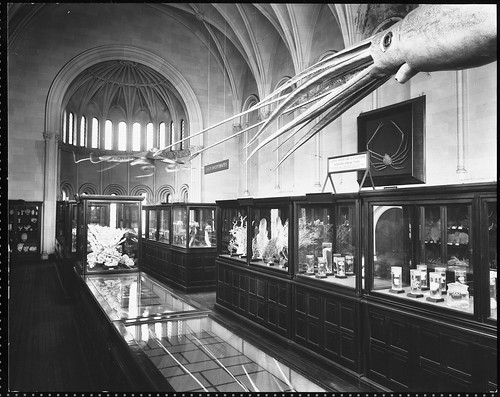
Lower Invertebrates Exhibit in West Wing, Smithsonian Institution Building
In another life I am a biologist. Even after 3 interstate moves in one year I still faithfully pack my 1935 edition of The American Natural Wildlife and Audubon's Birds of America. I am one of those naturalistic intelligence birds, if you buy into that whole theory of multiple intelligence bag. According to Howard Gardner my mind constantly looks for patterns: not numerical runs of numbers but patterns of inclusion and exception. This type of thinking is particularly keen on sorting the natural world into checklists of carnivores and omnivores, the nocturnal and the diurnal, the poisonous and the harmless.
Lately this tendency has been pushed into overdrive. Removed from the homogenized and antiseptic West End I feel like I am now surrounded by startling new wildlife. I spent part of Sunday afternoon with a guidebook in the park, learning to differentiate white oaks from chestnut oaks from southern red oaks. When the cat cornered a large and spidery insect with a hunched back I pulled out the guidebook and was delighted to discover it was Camel Cricket. A far cry from the fat black crickets of my youth, this beast was all legs and antennae and a close relative to the sinister, blind crickets I first saw in Mammoth Caves.
I have cultivated a warm observational relationship with two spiders living an odd communal life next to our front door. A small gray cellar spider maintains a messy web in the corner, spending the bulk of his day hanging upside-down off the bottom and waiting for moths. However, a lightning-quick wolf spider has made her home in the seam of the siding above and spends the twilight hours perched on the top of the web, waiting to steal a meal of her own. Incapable of spinning her own silk, she gladly uses the web available and the two spiders seem to live a peaceful, if not necessarily mutually beneficial existence. And I suppose this quiet coexistence extends to us too. We don't trouble them beyond shining our bike lights on them in the evening to try to catch sight of the elusive wolf spider, and occasionally tearing down the web when it becomes a little too unsightly (the cellar spider spins a new clean web within a day).
After all, there is plenty of room in this part of town for all of us, the spiders and the crickets, and people and the trees.
No comments:
Post a Comment